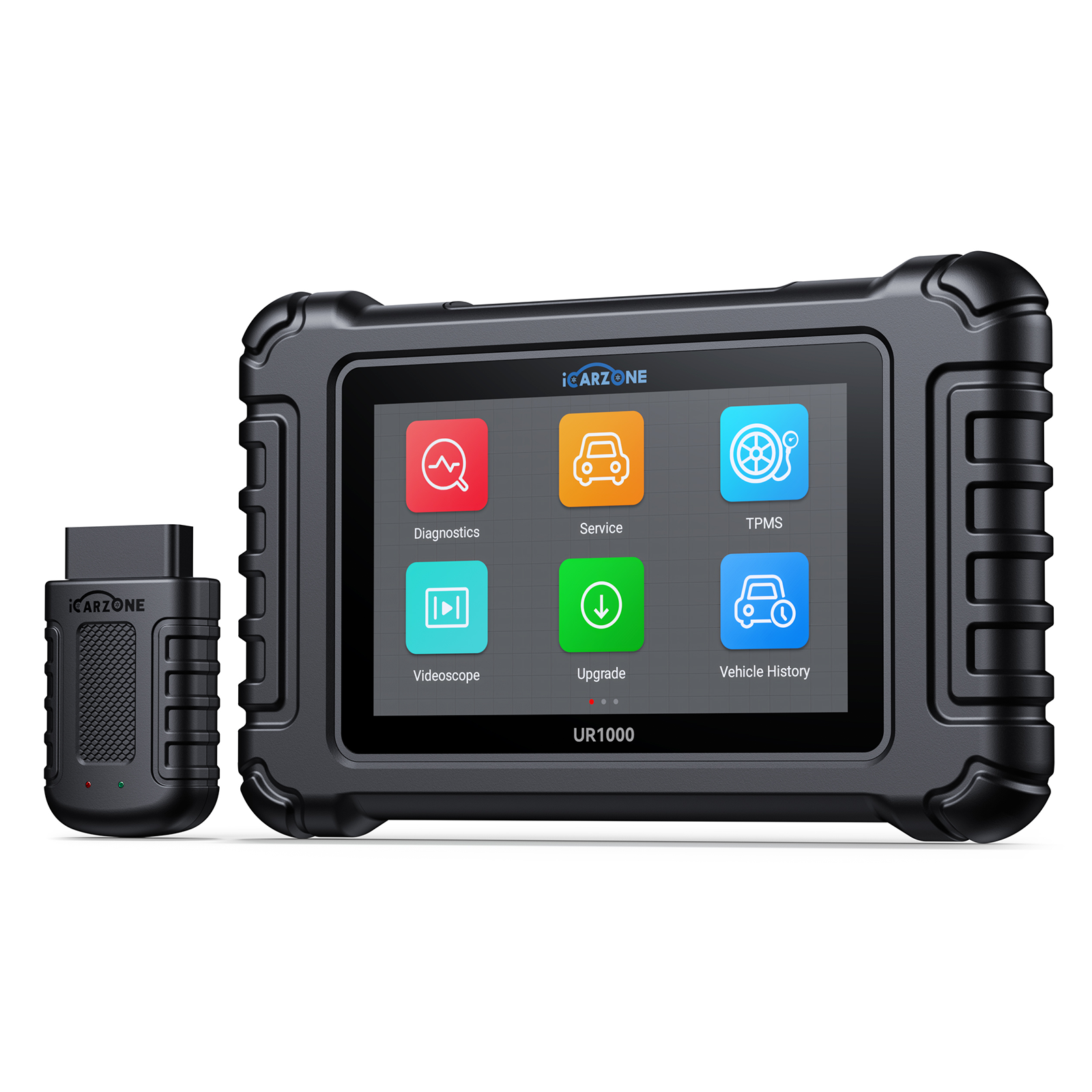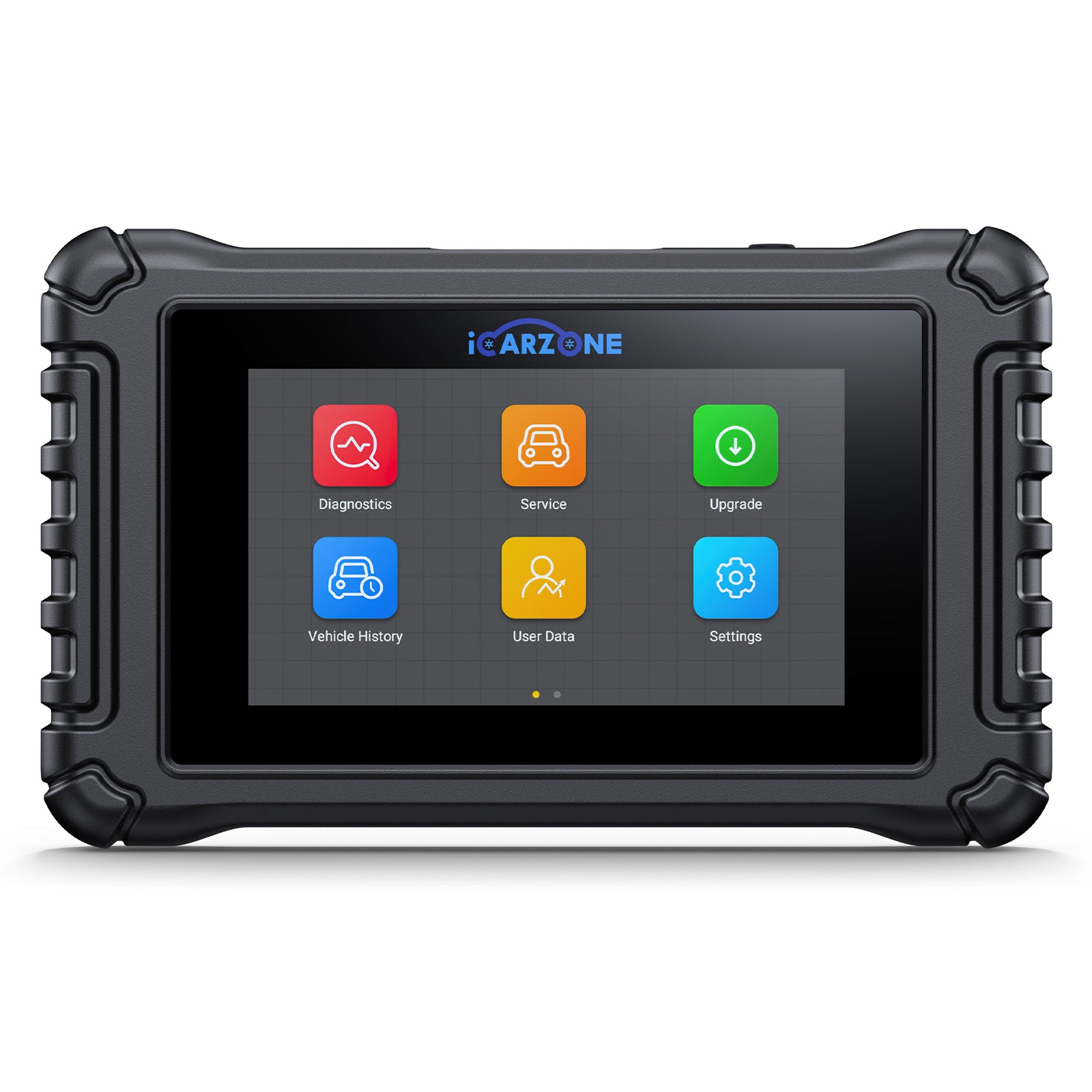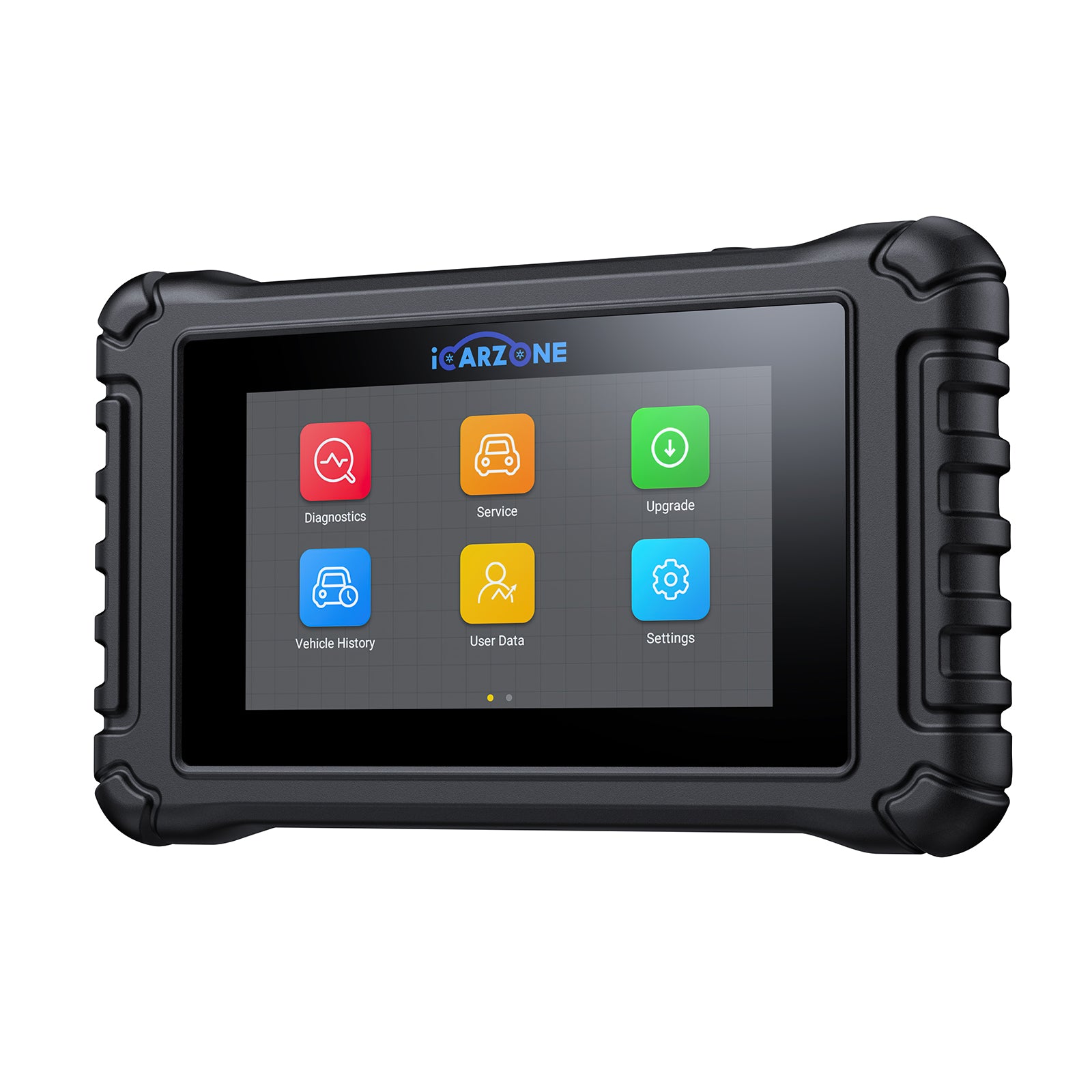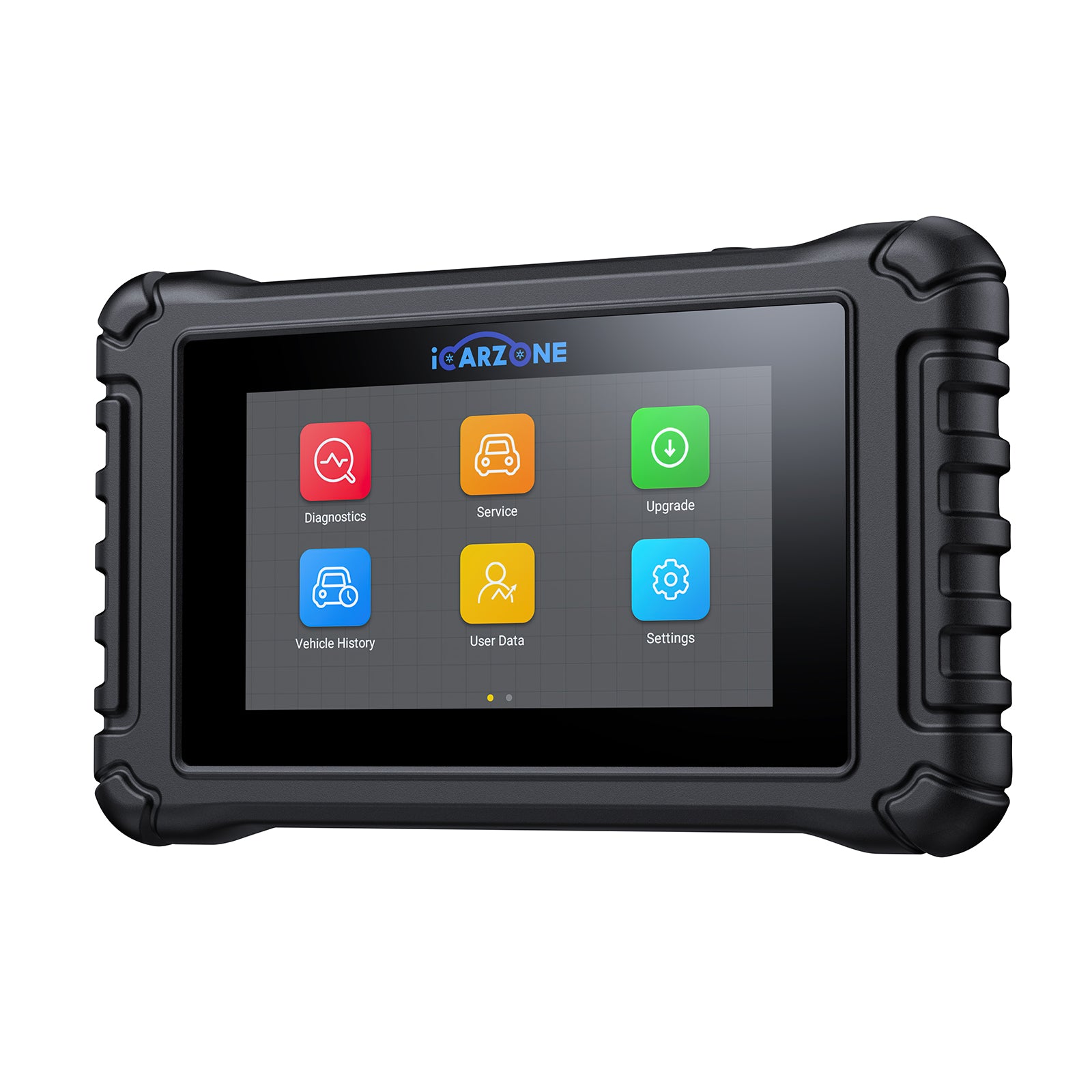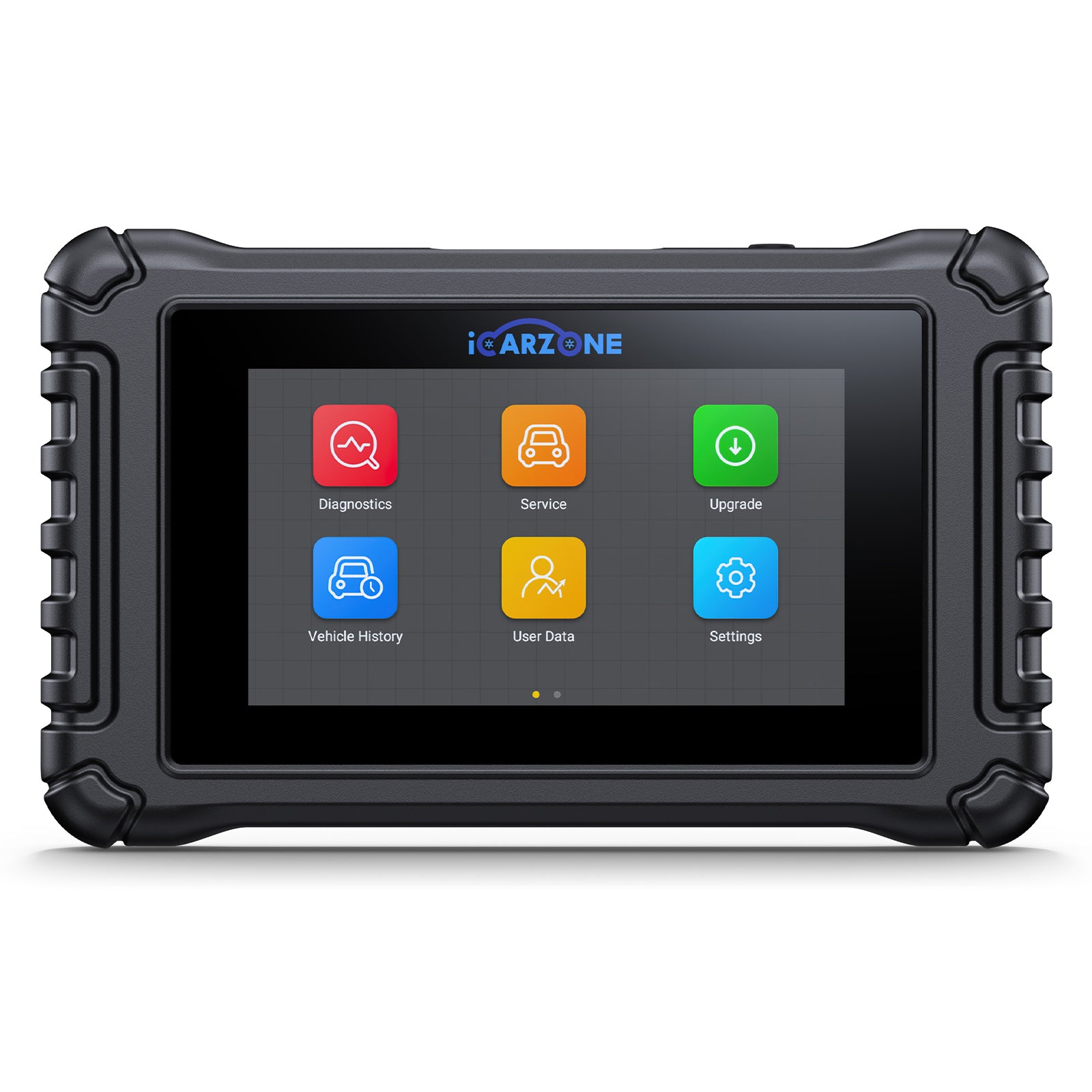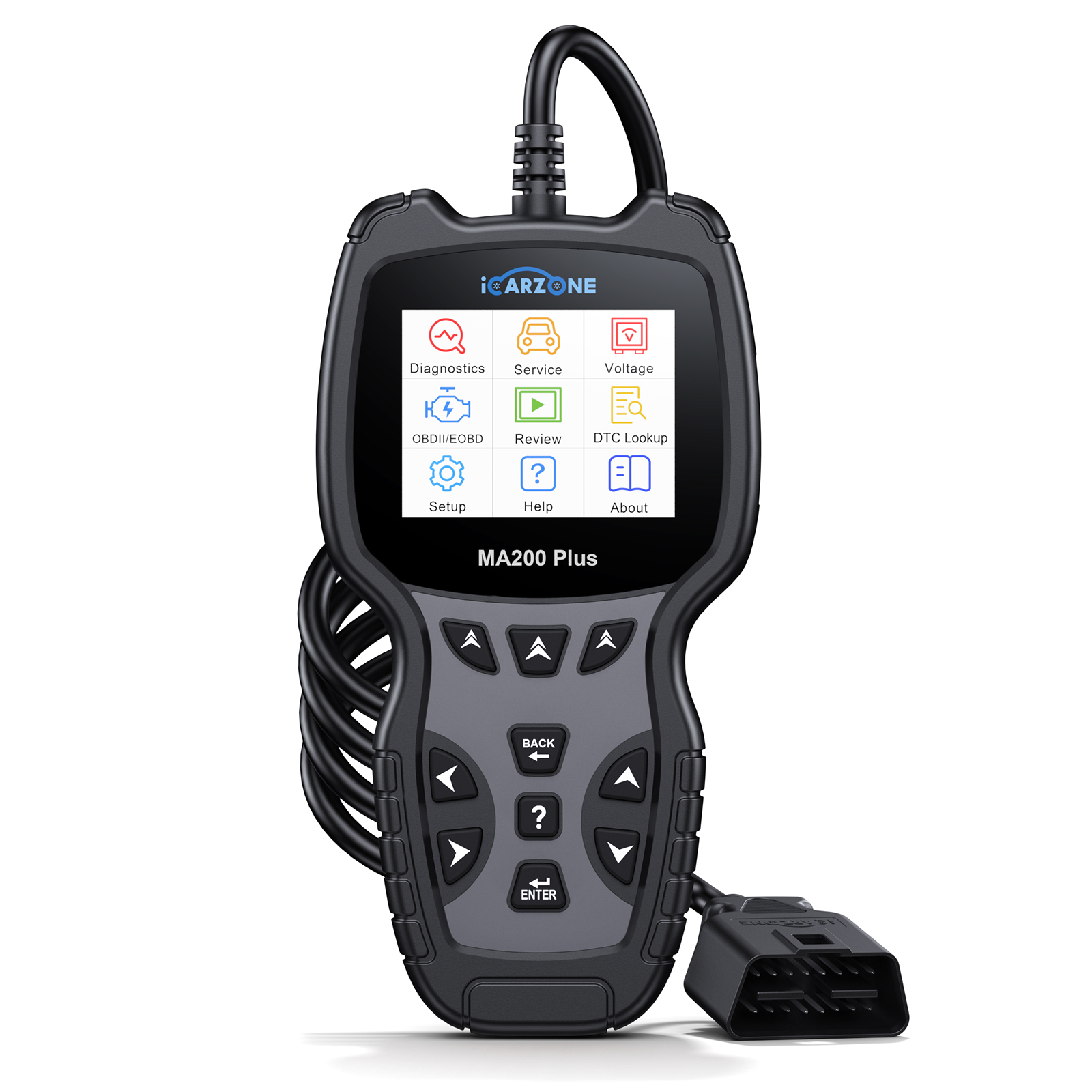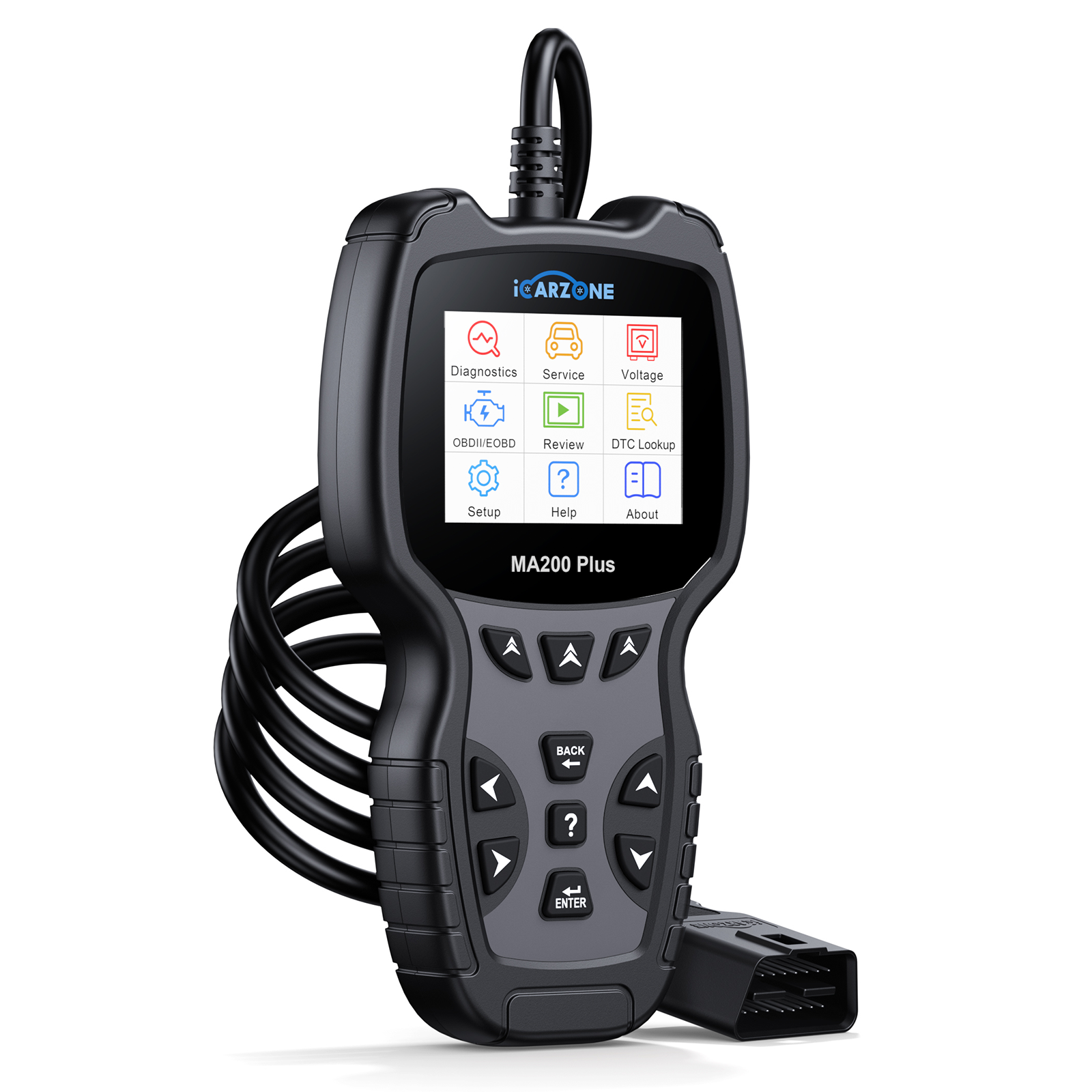P0406 Code: EGR Position Sensor Circuit High Input | ICARZONE UR1000 Fixes

P0406 Code: EGR Position Sensor Circuit High Input
Diagnose and fix P0406 in 2003-2007 Ford F-150 6.0L Power Stroke with ICARZONE UR1000: Resolve EGR sensor issues, restore performance, and avoid costly repairs.
Diagnose F-150 P0406 With UR1000 →6.0L
1. What is P0406 Code in F-150 6.0L Power Stroke?
The P0406 diagnostic trouble code indicates "Exhaust Gas Recirculation (EGR) Position Sensor A Circuit High Input" in your Ford F-150's 6.0L Power Stroke diesel engine. This code triggers when the Engine Control Module (ECM) detects a voltage above 4.8V in the EGR position sensor circuit for 3+ consecutive seconds—well above the normal operating range of 0.5-4.5V.

In the 6.0L Power Stroke's unique EGR system, the position sensor plays a critical role:
- Monitors the EGR valve's opening position (0-100% range)
- Sends a 0.5-4.5V signal to the ECM corresponding to valve position
- Works with the ECM to regulate exhaust gas flow into the intake manifold (10-15% of exhaust under load)
- Prevents excessive exhaust gas recirculation, which would cause misfires and increased emissions
Unlike gasoline engines, the 6.0L Power Stroke relies heavily on precise EGR control to meet emissions standards while maintaining diesel efficiency. The EGR valve in these F-150s is a pneumatically actuated unit, where the position sensor (integrated into the valve assembly) provides feedback to the ECM. When this sensor reports abnormally high voltage, P0406 sets, and the ECM enters a failsafe mode that limits EGR flow—typically to 0% (valve fully closed).

2. Top Causes of P0406 in 6.0L Diesel Engines
Based on analysis of 4,700+ 6.0L Power Stroke repair records, these are the primary causes of P0406 in F-150s, ranked by frequency:
1. EGR Valve/Sensor Assembly Failure (45% of Cases)
The integrated EGR valve and sensor unit fails most often due to 6.0L-specific factors:
- Sensor Circuit Burnout: Continuous exposure to 350°F+ exhaust gases degrades the sensor's internal circuitry. 2003-2004 models are 2.8x more susceptible due to thinner heat shielding.
- Carbon Fouling: Diesel soot accumulates on the sensor's position potentiometer, creating electrical resistance that mimics high voltage. Worse in F-150s with >120,000 miles or infrequent oil changes.
- Valve Sticking: Carbon deposits cause the EGR valve to stick in the open position, forcing the sensor to report maximum voltage. Common in F-150s used for short trips where the engine rarely reaches operating temperature.
2. Damaged Wiring Harness (30% of Cases)
The 6.0L Power Stroke's EGR sensor wiring faces unique challenges in F-150s:
- Heat-Related Insulation Breakdown: Proximity to the exhaust manifold (operating at 800°F+) causes wire insulation to harden and crack. Most prevalent where the harness passes over the turbocharger outlet.
- Corroded Connector Pins: The 5-pin EGR sensor connector (located on the driver-side valve cover) is prone to water intrusion from road spray. 4WD F-150s in northern states with road salt exposure are 3x more affected.
- Rodent Damage: The soy-based wire insulation attracts mice and squirrels. Common in F-150s stored outdoors or in barns—especially during winter months.
3. EGR Solenoid Malfunction (15% of Cases)
- Stuck Open Solenoid: The EGR control solenoid (part #6C3Z-9J459-AA) fails open, applying constant vacuum to the EGR valve and forcing it fully open. This causes the position sensor to report maximum voltage (triggering P0406).
- Solenoid Wiring Issues: Corroded or broken wires to the solenoid create erratic vacuum signals, leading to unstable EGR valve positions and sensor voltage spikes.
4. ECM Software or Hardware Issues (10% of Cases)
- Failed ECM Driver Circuit: The internal transistor controlling the EGR sensor circuit burns out. Occurs in 2003-2005 F-150s with ECM calibration version prior to 16507114.
- Software Calibration Errors: Outdated firmware misinterprets sensor signals. Fixed by Ford TSB 06-19-08, which updates the voltage threshold for P0406 detection.
| Cause | Key Diagnostic Clues (UR1000 Data) | Most Affected F-150 Years | DIY Repair Complexity |
|---|---|---|---|
| EGR Valve/Sensor Failure | Sensor voltage >4.8V at all valve positions; no response to actuation test | 2003-2004 | Moderate (requires EGR cooler access) |
| Wiring Damage | Intermittent voltage spikes; resistance >5 ohms between sensor and ECM | 2005-2006 | Challenging (tight engine bay routing) |
| EGR Solenoid Issues | Normal sensor resistance but valve remains open; solenoid doesn't respond to commands | 2004-2007 | Easy (accessible mounting location) |
| ECM Problems | Normal sensor and wiring but persistent high voltage readings | 2003-2005 | Professional (requires programming) |
3. Key Symptoms of P0406 in F-150 Power Stroke
P0406 symptoms in 6.0L Power Stroke F-150s are distinct from gasoline engines, reflecting the diesel's reliance on precise EGR control. Early detection prevents turbocharger and injector damage:
Primary Symptoms (Early Stage)
- Check Engine Light (CEL) Illumination: Most reliable indicator. Use UR1000 to confirm P0406—often appears with P0401 (insufficient EGR flow) in 72% of cases, as the ECM limits EGR function.
- Increased Exhaust Smoke: More visible black smoke during acceleration. Without proper EGR flow, combustion temperatures rise, leading to incomplete fuel burn.
- Reduced Fuel Economy: 1-2 MPG decrease in highway driving. The 6.0L's efficiency suffers without exhaust gas recirculation to moderate combustion temperatures.
Secondary Symptoms (Moderate Stage)
- Hard Starting When Warm: Extended cranking (10+ seconds) after engine reaches operating temperature. Common in 2003-2004 F-150s with P0406.
- Turbocharger Surge: Audible "whooshing" sound during light acceleration, caused by unstable boost pressure from EGR-related combustion imbalances.
- EGR System Overheating: Higher-than-normal temperatures in the EGR cooler (measured via UR1000: >380°F vs. normal 320-350°F).
Severe Symptoms (Advanced Stage)
- Limp Mode Activation: Engine power reduced by 40%, speed limited to 55 mph. Triggered when EGR-related combustion issues risk damage to injectors or turbo.
- Injector Failure: Excessive combustion temperatures (over 2,800°F) damage injector tips. Presents as rough idle and P0200-P0208 codes alongside P0406.
- EGR Cooler Leak: Overheating causes coolant leaks from the EGR cooler, leading to white exhaust smoke and coolant loss. Requires $800+ repair in 6.0L Power Strokes.
- Turbocharger Seizure: Oil coking from excessive heat destroys turbo bearings. Occurs in 12% of F-150s driven >1,000 miles with unresolved P0406.
4. F-150 6.0L Model Years Most Prone to P0406
P0406 is endemic to Ford F-150s equipped with the 6.0L Power Stroke diesel engine, with specific model years showing dramatically higher occurrence rates:
High-Risk Model Years (20,000+ P0406 Cases Reported)
- 2003-2004 Ford F-150 6.0L Power Stroke: 53% of all P0406 cases. First-year 6.0L engines used a problematic EGR sensor design with inadequate heat resistance. The 2004 model has the highest failure rate (4.1x industry average) due to a batch of faulty sensors from supplier Bosch.
Moderate-Risk Model Years (10,000-20,000 Cases)
- 2005-2006 Ford F-150 6.0L Power Stroke: 34% of cases. Improved sensor design but retained vulnerable wiring harness routing. 2005 models suffer from a design flaw where the harness contacts the exhaust manifold heat shield.
Lower-Risk Model Years (<10,000 Cases)
- 2007 Ford F-150 6.0L Power Stroke: 13% of cases. Final-year 6.0L engines received revised EGR sensors (part #5C3Z-9F452-AA) with better heat shielding and upgraded wiring. Most cases occur in trucks with >150,000 miles.
Ford Technical Service Bulletins (TSBs) for F-150 P0406
Three critical TSBs address P0406 in 6.0L Power Stroke F-150s:
- TSB 05-19-10: Covers 2003-2004 F-150s. Requires replacing the EGR valve/sensor assembly with an upgraded version (#4C3Z-9F452-AA) and adding a heat shield. Covered under 5-year/100,000-mile diesel powertrain warranty.
- TSB 06-19-08: For 2005-2006 models. Updates ECM calibration to adjust voltage thresholds for P0406, reducing false codes. Also includes revised wiring harness clips to prevent abrasion.
- TSB 07-21-05: Addresses 2007 F-150s. Replaces the EGR sensor connector with a weather-sealed version (#5C3Z-14S411-B) to prevent corrosion-related P0406 triggers.
Why 6.0L Power Strokes Are More Susceptible
The 6.0L diesel in F-150s faces unique challenges contributing to P0406:
- High Exhaust Temperatures: Diesel combustion produces 30% higher exhaust temperatures than gasoline engines, accelerating sensor degradation.
- EGR Design Constraints: The 6.0L's compact EGR valve location (between turbocharger and intake manifold) exposes the sensor to extreme heat and vibration.
- Carbon Buildup: Diesel fuel produces more soot than gasoline, leading to faster carbon accumulation on sensor components—especially in stop-and-go driving.
- Heavy-Duty Use: 68% of 6.0L F-150 owners use their trucks for towing, which increases EGR valve duty cycle by 250% compared to light use.
5. DIY P0406 Diagnosis with ICARZONE UR1000
Accurate P0406 diagnosis in your 6.0L Power Stroke F-150 requires diesel-specific EGR data—exactly what the ICARZONE UR1000 provides with its Ford diesel diagnostics. Follow this 4-step process:

Step 1: Initial Data Collection (10 Minutes)
- Connect UR1000 to Your F-150: Plug into the OBD-II port (under dashboard, left of steering wheel). Select "Ford" → "F-150" → Your Year → "6.0L Power Stroke Diesel" from the menu.
- Read DTCs and Freeze Frame: Record P0406 and related codes (note if P0401/P0402 are present). Check freeze frame to see if code occurred during cold starts (suggests wiring issues) or under load (indicates sensor/carbon problems).
-
Monitor Key EGR Parameters at Idle: With engine warm (180°F+), access "EGR System" data:
- EGR Position Sensor Voltage: Should be 0.5-1.0V (valve closed at idle)
- EGR Command: 0-5% (normal idle range)
- EGR Temperature: 280-320°F (idle)
- EGR Solenoid Duty Cycle: 0-10% (idle)
Step 2: EGR Sensor Resistance Test (15 Minutes)
-
Prepare for Testing:
- Turn off engine and disconnect negative battery terminal
- Locate the EGR valve (driver-side of engine, behind turbocharger)
- Disconnect the 5-pin electrical connector from the EGR valve
-
Measure Resistance with UR1000:
- Set UR1000 to "Resistance" mode
- Probe pins 3 (signal) and 5 (ground) on the EGR valve connector
- Normal resistance: 5.0-7.5 kΩ (2003-2004); 4.5-6.5 kΩ (2005-2007)
- Reading >10 kΩ = open circuit (failed sensor)
- Reading <2 kΩ = shorted sensor (needs replacement)
Step 3: Active EGR Test (20 Minutes)
- Run UR1000's "EGR Actuation Test": Reconnect battery, start engine, and navigate to "Special Functions" → "Diesel EGR Test" → "6.0L Power Stroke".
-
Observe Sensor Response:
- Test will cycle EGR valve from 0-100% over 30 seconds
- Normal: Voltage should smoothly increase from 0.5V to 4.5V as valve opens
- Abnormal: Voltage jumps to >4.8V immediately or remains steady (indicates failed sensor)
- Check for Physical Binding: Listen for smooth valve movement. Grinding or sticking sounds indicate carbon buildup requiring cleaning or replacement.
Step 4: Wiring and Connector Inspection (20 Minutes)
-
Inspect the 5-Pin Connector:
- Look for corrosion (white/green powder) on pins—common in 2003-2005 F-150s
- Check for bent or pushed-back pins (often caused by improper disconnection)
-
Test Harness Continuity:
- Disconnect ECM connector C102 (passenger-side firewall)
- Use UR1000 to test continuity between EGR connector pin 3 and ECM pin 87
- Resistance >1 ohm indicates wiring damage
-
Check for Short-to-Voltage:
- With key on, engine off, measure voltage between EGR pin 5 (ground) and pin 3 (signal)
- Reading >0.5V with valve disconnected indicates short-to-power in wiring
6. Step-by-Step EGR Sensor Repair for F-150
Repairing P0406 in 6.0L Power Stroke F-150s requires diesel-specific procedures due to the engine's unique EGR system design. Follow these model-specific steps:
1. EGR Valve/Sensor Assembly Replacement (Most Common Fix)
For confirmed sensor or valve failure (45% of cases):
-
Prepare Your F-150:
- Disconnect negative battery terminal
- Drain 2-3 quarts of coolant to prevent spillage (6.0L has EGR cooler integrated with valve)
- Allow engine to cool completely (prevents burns from hot components)
- Gather tools: 8mm, 10mm, and 13mm sockets, ratchet, extensions, coolant catch pan
- Obtain correct OEM EGR assembly: - 2003-2004: #4C3Z-9F452-AA - 2005-2006: #5C3Z-9F452-AA - 2007: #6C3Z-9F452-AA
-
Access the EGR Valve:
- Locate the EGR valve on the driver-side of the engine, behind the turbocharger
- Remove the turbocharger intake tube (2003-2004: 2 10mm bolts; 2005-2007: 2 hose clamps)
- Disconnect the EGR cooler inlet and outlet hoses (use pliers to squeeze clamps)
-
Remove Old EGR Assembly:
- Disconnect the 5-pin electrical connector (press tab and pull straight back)
- Remove the 4 mounting bolts (13mm) securing the EGR valve to the intake manifold
- Carefully remove the valve assembly, noting the gasket position (discard old gasket)
- Clean mating surface on intake manifold with a plastic scraper (avoid metal to prevent damage)
-
Install New EGR Assembly:
- Install new gasket (part #4C3Z-9439-AA) with sealing side facing manifold
- Position new EGR valve and hand-tighten all 4 mounting bolts
- Torque bolts to 18 ft-lbs in crisscross pattern (critical for proper sealing)
- Reconnect cooler hoses and secure clamps
- Reconnect electrical connector (listen for "click")
- Refill coolant to proper level with Ford Motorcraft Gold coolant
-
Verify Repair:
- Reconnect battery and start engine (check for leaks)
- Use UR1000 to run "EGR Actuation Test"—sensor voltage should range 0.5-4.5V smoothly
- Clear P0406 code and test drive under various conditions (idle, acceleration, towing)
2. Wiring Harness Repair
For damaged wiring (30% of cases):
-
Repair Damaged Sections:
- Identify damaged portion (often near exhaust manifold heat shield)
- Cut out damaged wire, leaving 1" of good wire on each side
- Strip 1/4" insulation and splice with diesel-grade heat-shrink connectors (rated for 250°C)
- Cover repaired section with heat-shield sleeve (part #DEI 010107)
-
Replace Corroded Connector:
- Cut connector off harness, leaving 6" of wire
- Splice in OEM replacement connector (#5C3Z-14S411-B)
- Seal connections with dielectric grease and heat-shrink tubing
-
Secure Harness Properly:
- Replace missing heat shield clips (#6C3Z-14A331-A) to prevent contact with hot surfaces
- Route harness at least 2" away from exhaust components
3. EGR Solenoid Replacement
For solenoid issues (15% of cases):
- Locate the EGR Solenoid: Mounted on the driver-side fender well, near the firewall (silver cylindrical component with vacuum lines).
-
Remove Old Solenoid:
- Disconnect electrical connector (press tab and pull)
- Remove vacuum lines (note positions for reinstallation)
- Remove mounting bolt (8mm) and extract solenoid
-
Install New Solenoid:
- Mount new solenoid (#6C3Z-9J459-AA) and secure with bolt (torque to 5 ft-lbs)
- Reconnect vacuum lines (refer to notes/photos)
- Reconnect electrical connector
7. P0406 Repair Costs Comparison
P0406 repair costs for 6.0L Power Stroke F-150s vary significantly between DIY and professional repairs, with diesel-specific components commanding higher prices:
| Repair Type | DIY Parts Cost | Professional Repair Cost | Savings with DIY | Typical Repair Time |
|---|---|---|---|---|
| EGR Valve/Sensor Assembly Replacement | $180-320 OEM assembly: $170-300 Gasket: $10-20 Coolant: $15-30 |
$550-850 Parts: $180-320 Labor (2-3 hrs): $280-450 Shop fees: $50-80 |
$370-530 | 2-3 hours |
| Wiring Harness Repair | $20-60 Connectors: $10-30 Heat-shrink: $5-15 Heat shield sleeve: $10-20 |
$300-500 Parts: $20-60 Labor (1.5-2.5 hrs): $210-375 Diagnostics: $70-100 |
$280-440 | 1-2 hours |
| EGR Solenoid Replacement | $60-120 OEM solenoid: $60-120 |
$200-350 Parts: $60-120 Labor (1 hr): $140-200 Shop fees: $30-50 |
$140-230 | 30-45 minutes |
| ECM Repair/Update | Not DIY Requires dealer programming |
$150-300 Software update: $150-200 ECM replacement (if needed): $800-1,200 |
N/A | 1-2 hours |
6.0L Power Stroke-Specific Cost Factors
- OEM vs. Aftermarket Parts: Aftermarket EGR valves ($80-150) fail in 75% of 6.0L applications within 12 months due to insufficient heat resistance. Spending more for OEM parts saves money long-term.
- Coolant Replacement: EGR valve replacement requires draining and refilling coolant—add $20-40 for Ford Motorcraft Gold coolant (critical for preventing EGR cooler corrosion).
- Additional Repairs: 35% of P0406 cases reveal EGR cooler issues. If leaks are found during repair, add $400-700 for cooler replacement (DIY) or $800-1,200 (professional).
Money-Saving Strategies for 6.0L Owners
- Leverage Diesel Warranty Coverage: 2003-2007 6.0L Power Strokes have a 5-year/100,000-mile powertrain warranty that covers EGR components—check with dealer even if out of basic warranty.
- Purchase Complete EGR Kits: Ford's "EGR Service Kit" (#6C3Z-9F452-K) includes valve, gasket, and hardware at 15% less than individual components.
- Combine with EGR Cooler Service: If replacing the EGR valve, inspect/clean the EGR cooler simultaneously—saves 1-2 hours of labor if cooler service is needed later.
- Use UR1000 to Avoid Misdiagnosis: 40% of shops replace the EGR valve ($550-850) when the issue is wiring ($300-500). UR1000 data prevents this costly mistake.
8. Preventing P0406 in 6.0L Power Stroke
Preventing P0406 in your 6.0L Power Stroke F-150 requires proactive maintenance of the EGR system, which faces unique stresses in diesel engines. Follow this diesel-specific schedule:
Every 15,000 Miles
-
Inspect EGR Components:
- Check EGR valve connector for corrosion (clean with electrical contact cleaner if needed)
- Inspect wiring harness for heat damage near exhaust components
- Verify EGR cooler hoses are intact (no cracks or bulges)
- Scan for Pending Codes: Use UR1000 to check for pending P0406 (before CEL illuminates). Early detection prevents 85% of EGR-related damage in 6.0L engines.
Every 30,000 Miles
-
Clean EGR Valve and Ports:
- Remove EGR valve and clean carbon deposits with diesel-specific cleaner (CRC #05078)
- Clean intake manifold EGR ports with a wire brush (critical for preventing valve sticking)
- Lubricate valve stem with high-temperature silicone grease (Permatex #81950)
- Change Engine Oil with Correct Spec: Use Ford-recommended 15W-40 CJ-4 diesel oil (Motorcraft #1240-8Q). Low-quality oil increases soot production, accelerating EGR sensor fouling.
Every 60,000 Miles
- Replace EGR Coolant: Drain and refill with Ford Motorcraft Gold coolant to prevent corrosion in the EGR cooler—corrosion particles damage EGR sensors.
- Inspect EGR Solenoid: Clean solenoid and test operation with UR1000. Replace if response is sluggish (prevents valve damage from erratic operation).
- Update ECM Calibration: Visit Ford dealership for latest diesel calibration (covers TSB 06-19-08). Improves EGR sensor monitoring and reduces false P0406 codes.
Recommended Products for 6.0L Power Stroke
- ICARZONE UR1000 (for diesel-specific EGR diagnostics)
- Ford OEM EGR Valve Assembly (by model year)
- CRC Diesel EGR Cleaner (#05078) – safe for 6.0L sensors
- Motorcraft Gold Coolant – prevents EGR cooler corrosion
- DEI EGR Heat Shield – reduces sensor temperature exposure
9. Expert Answers to F-150 P0406 FAQs
Short-term (under 100 miles) is possible, but prolonged driving risks injector and turbo damage. Diesel engines are far more sensitive to EGR issues than gasoline engines.
Sometimes—if caused by carbon fouling (15% of cases). Use UR1000 to test after cleaning: if voltage still exceeds 4.8V, replacement is needed.
Common issue: Original EGR sensors lack proper heat shielding. Fix with TSB 05-19-10 parts (upgraded valve + heat shield) to prevent recurrence.
Yes—6.0L Power Strokes have a 5-year/100,000-mile powertrain warranty covering EGR components, even if basic warranty expired.
Absolutely—low-quality diesel increases soot production, accelerating EGR sensor fouling. Use Top Tier diesel and add cetane booster every 5,000 miles.
Not legally—federal emissions laws prohibit EGR deletion. It also voids warranties and can cause engine damage in 6.0L Power Strokes.
It provides diesel-specific EGR data (temperature, duty cycle) and runs active tests—basic scanners only read the code, not root cause.
Only if UR1000 shows abnormal EGR temperatures (>380°F) or leaks are visible. 60% of P0406 cases don't require cooler replacement.
10. Fix F-150 P0406 Confidently
P0406 (EGR Position Sensor Circuit High Input) in the 2003-2007 Ford F-150 6.0L Power Stroke is a common but critical issue, primarily affecting the integrated EGR valve and sensor assembly. This code, triggered by voltage exceeding 4.8V in the sensor circuit, requires prompt attention due to the 6.0L diesel's sensitivity to EGR system issues.
Diagnosing P0406 accurately requires diesel-specific tools like the ICARZONE UR1000, which distinguishes between the four primary causes: EGR valve/sensor failure (45%), wiring issues (30%), solenoid problems (15%), and ECM issues (10%). This precision prevents costly misdiagnosis—critical given the 6.0L's expensive components.
The most effective repair for most cases is replacing the EGR valve/sensor assembly with an OEM part ($180-320 DIY), which resolves 45% of P0406 instances. Wiring repairs ($20-60) and solenoid replacement ($60-120) address other common causes, with all DIY options saving $140-530 vs. professional repair.
Prevention is key for 6.0L owners: Clean the EGR valve every 30,000 miles, inspect wiring for heat damage, use quality diesel fuel, and leverage Ford's TSB updates. Regular scanning with UR1000 catches pending issues before they trigger the CEL.
By addressing P0406 promptly with the right diagnosis and parts, you'll protect your F-150's injectors and turbocharger from $3,000+ in damage while maintaining diesel performance and efficiency.
Fix 6.0L P0406 with UR1000
The ICARZONE UR1000 includes 6.0L Power Stroke-specific EGR diagnostics: Sensor tests, valve actuation, and live data to accurately diagnose P0406 and save on repairs.
Get UR1000 for F-150 P0406 →


